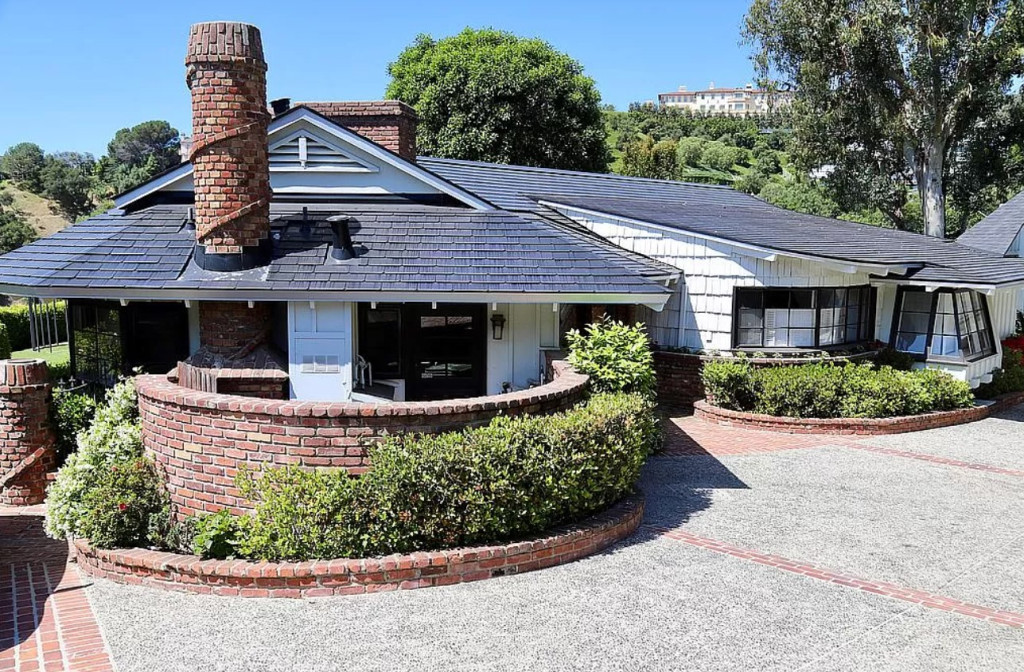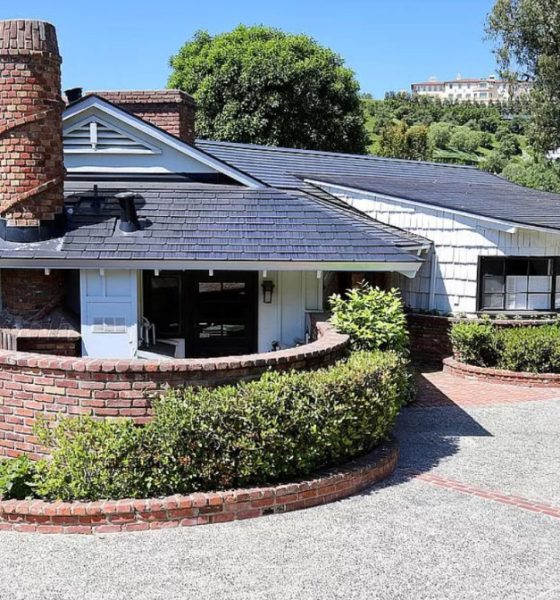In a world inundated by negativity, controversy, and now, war, tales of people and small acts of kindness matter. They may not hold a lot of never-before-seen information, nor do they include the latest shocking thing that today’s influencers are engaged in, but they do, from time to time, tell a remarkably human story. The tale of late Hollywood legend Gene Wilder’s home, and how it made it back to the actor’s family under a surprising turn of events, is one of these stories.
Back in 2020, Tesla CEO Elon Musk announced that he would be offloading all his residential properties in California as a way to trim down his possessions. Musk, who owned Wilder’s house, noted that whoever purchases the late actor’s home would have to preserve it. Musk did make improvements to the home like a Tesla Solar Roof installation and Powerwall batteries, but for the most part, the property still retained the spirit it had when Wilder was still living in it.
Filings eventually revealed that the estate was sold to an LLC whose sole manager was listed as Elizabeth Hunter, a screenwriter and TV producer who happens to be married to filmmaker Jordan Walker-Pearlman, who is Wilder’s nephew. Walker-Pearlman recently shared with The Wall Street Journal that his purchase of his late uncle’s home from Musk had been a rather unique experience. The filmmaker stated that he actually spent summers in the Bel-Air home with his uncle, and his experiences in the house made him intimately familiar with the property.
As it is with many stories involving Musk, Walker-Pearlman’s journey into acquiring his late uncle’s home started with a dose of misinformation. According to the late actor’s nephew, he was initially told that the home had been demolished, which made him mourn the house. But while he was in the neighborhood one day with his wife, the filmmaker was pleasantly surprised to see the house still standing. Tesla CEO Elon Musk owned the home then, and a large party was underway. Quite surprisingly, the security guard in the property opened the gate for the couple so Walker-Pearlman and Hunter could peek inside.
It took about a year later when Walker-Pearlman saw the tweet that would effectively change the fate of Wilder’s quirky Bel-Air home. Musk’s stipulation was perfect for the filmmaker, as he would actually want to keep the property and all its quirky characteristics preserved. However, there was just one issue: the home had appeared on forsalebyowner.com with an asking price of $9.5 million. Walker-Pearlman knew that he personally could not afford the property’s $9.5 million asking price, but Musk’s tweet provided him with some optimism that something could be arranged.
And so four months of negotiations started. Fortunately for the filmmaker, the Tesla CEO proved quite understanding, with Musk bringing down the price of the late actor’s Bel-Air home to $7 million, together with what was dubbed as a “long form deed of trust and assignment of rents.” Even more surprisingly, Musk agreed to lend Walker-Pearlman and Hunter $6.7 million to finance the home. It was a surprising twist on the story of Wilder’s house, as its new owners were able to effectively move into a home initially listed for $9.5 million with a $300,000 downpayment.
It was a gesture that was well appreciated by Walker-Pearlman. “He could have sold it for so much more. His sensitivity to me can’t be overstated,” he said. Hunter, for her part, told the Journal that she is quite thrilled to have the chance to reside in such a beautiful home in a neighborhood that she and her husband would otherwise not be able to afford. “It’s magic,” she said.
Interestingly enough, Walker-Pearlman closed the sale with Musk in October 2020. It was perfect timing since the filmmaker was shooting a movie called “The Requiem Boogie,” which was produced by his production company, Harlem,Hollywood. Wilder’s home ultimately became the set for the film, which is a rather autobiographical tale that features a middle-aged former child actor mourning the loss of his movie-star father. Considering the personal nature of the story, having the movie shot in the Wilder’s Bel-Air home is something that was likely a fairly spiritual experience for Walker-Pearlman.
Don’t hesitate to contact us with news tips. Just send a message to simon@teslarati.com to give us a heads up.

Lifestyle
Tesla Model S Plaid battles China’s 1500 hp monster Nurburgring monster, with surprising results
There is just something about Tesla’s tuning and refinement that makes raw specs seem not as game-changing.

The Tesla Model S Plaid has been around for some time. Today, it is no longer the world’s quickest four-door electric sedan, nor is it the most powerful. As per a recent video from motoring YouTube channel Carwow, however, it seems like the Model S Plaid is still more than a match for some of its newer and more powerful rivals.
The monster from China
The Xiaomi SU7 Ultra is nothing short of a monster. Just like the Model S Plaid, it features three motors. It also has 1,548 hp and 1,770 Nm of torque. It’s All Wheel Drive and weighs a hefty 2,360 kg. The vehicle, which costs just about the equivalent of £55,000, has been recorded setting an insane 7:04.957 at the Nurburgring, surpassing the previous record held by the Porsche Taycan Turbo GT.
For all intents and purposes, the Model S Plaid looked outgunned in Carwow’s test. The Model S Plaid is no slouch with its three motors that produce 1,020 hp and 1,420 Nm of torque. It’s also a bit lighter at 2,190 kg despite its larger size. However, as the Carwow host pointed out, the Model S Plaid holds a 7:25.231 record in the Nurburgring. Compared to the Xiaomi SU7 Ultra’s record, the Model S Plaid’s lap time is notably slower.
Real-world tests
As could be seen in Carwow’s drag races, however, Tesla’s tech wizardry with the Model S Plaid is still hard to beat. The two vehicles competed in nine races, and the older Model S Plaid actually beat its newer, more powerful counterpart from China several times. At one point in the race, the Xiaomi SU7 Ultra hit its power limit due to its battery’s temperature, but the Model S Plaid was still going strong.
The Model S Plaid was first teased five years ago, in September 2020 during Tesla’s Battery Day. Since then, cars like the Lucid Air Sapphire and the Xiaomi SU7 Ultra have been released, surpassing its specs. But just like the Model Y ended up being the better all-rounder compared to the BYD Sealion 7 and the MG IM6, there is just something about Tesla’s tuning and refinement that makes raw specs seem not as game-changing.
Check out Carwow’s Model S Plaid vs Xiaomi SU7 drag race video below.
Lifestyle
500-mile test proves why Tesla Model Y still humiliates rivals in Europe
On paper, the BYD Sealion 7 and MG IM6 promised standout capabilities against the Model Y.

BYD is seeing a lot of momentum in Europe, so much so that mainstream media has taken every opportunity to argue that the Chinese automaker has beaten Tesla in the region. But while BYD sales this year in Europe are rising and Tesla’s registrations remain challenged, the raw capabilities of vehicles like the Model Y are difficult to deny.
This was highlighted in a 500-mile challenge by What Car? magazine, which showed that the new Tesla Model Y is more efficient, cheaper to run, and more reliable than rivals like the BYD Sealion 7, and even the nearly 400 KW-charging MG IM6.
Range and charging promises
On paper, the BYD Sealion 7 and MG IM6 promised standout capabilities against the Model Y. The Sealion 7 had more estimated range and the IM6 promised significantly faster charging. When faced with real-world conditions, however, it was still the Model Y that proved superior.
During the 500-mile test, the BYD nearly failed to reach a charging stop, arriving with less range than its display projected, as noted in a CarUp report. MG fared better, but its charging speeds never reached its promised nearly-400 kW charging speed. Tesla’s Model Y, by comparison, managed energy calculations precisely and arrived at each stop without issue.
Tesla leads in areas that matter
Charging times from 25% to 80% showed that the MG was the fastest at 17 minutes, while Tesla and BYD were close at 28 and 29 minutes, respectively. Overall efficiency and cost told a different story, however. The Model Y consumed 19.4 kWh per 100 km, compared to 22.2 for MG and 23.9 for BYD. Over the full trip, Tesla’s charging costs totaled just £82 thanks to its supercharger network, far below BYD’s £130 and MG’s £119.
What Car? Magazine’s testers concluded that despite BYD’s rapid sales growth and the MG IM6’s seriously impressive charging speeds, Tesla remains the more compelling real-world choice. The Model Y just offers stability, efficiency, and a proven charging infrastructure through its Supercharging network. And as per the magazine’s hosts, the Model Y is even the cheapest car to own among the three that were tested.
Watch What Car? Magazine’s 500-mile test in the video below.
Lifestyle
Tesla Cybertruck slapped with world’s least intimidating ticket, and it’s pure cringe
One cannot help but cringe and feel second-hand embarrassment at the idea of a person just driving around with a stack of these babies.

A Cybertruck parked at Stanford Shopping Center in California was recently hit with what might be the most try-hard piece of paper ever slipped under a wiper blade: a “fake citation” accusing the driver of supporting a “fascist car.”
The note, shared on X by Tesla staff program manager Ryan Torres, quickly made the rounds on X, where it quickly gained attention as an example of how not to protest.
The world’s least intimidating ticket
According to the citation, the supposed “violation” was “driving a fascist car.” The remedial action? Take the bus, call an Uber, or ride a bike. The note also dubbed Elon Musk a “chainsaw-wielding Nazi billionaire.” Now, protests against Tesla and Elon Musk have become commonplace this year, but one cannot help but cringe and feel second-hand embarrassment at the idea of a person just driving around with a stack of fake anti-Tesla/Musk citations.
Torres pointed out the irony himself in his post on X. Tesla currently employs over 140,000 Americans, and SpaceX has put the U.S. firmly back at the top of space technology. As Torres put it, maybe the person behind the world’s least intimidating ticket should “read a book on innovation before vandalizing” other people’s property.
Peak performative clownery
Not to mention that the fake ticket’s logic collapses under its own weight. EVs like the Cybertruck are literally designed to reduce emissions, not “destroy the economy.” If anything, Tesla has bolstered the United States’ economy by fueling jobs in engineering, manufacturing, and clean energy. It’s not the first time a Tesla has been the target of vandalism or politically charged notes, but this one stands out for sheer cringe value.
Torres summed it up neatly: “Peak clownery.” On that point, at least, the citation earns full marks. In a way, though, perhaps cringe fake tickets are not as bad as the literal firebombs that were being thrown at Tesla stores and cars earlier this year because some critics were gleefully misinformed about Elon Musk.










